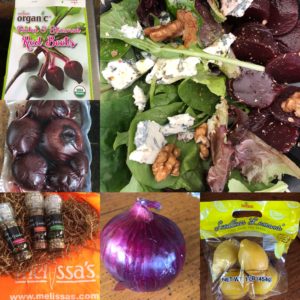The (Melissa’s Instant) Beet Goes On!
 (Gerry Furth-Sides) Beets have intriguing and upside down a delicious history as both an earthy, sweet veggie, and as a sugar used in other products. Today the beet, goat cheese, hazelnut salad has become so popular a restaurant menu item that trendy chefs like David Chang make fun of it as, “trite.” Shame on you, Chang! It’s popular because this classic always satisfies. Why don’t you just do a variation of your own? Hints are below.
(Gerry Furth-Sides) Beets have intriguing and upside down a delicious history as both an earthy, sweet veggie, and as a sugar used in other products. Today the beet, goat cheese, hazelnut salad has become so popular a restaurant menu item that trendy chefs like David Chang make fun of it as, “trite.” Shame on you, Chang! It’s popular because this classic always satisfies. Why don’t you just do a variation of your own? Hints are below.
The beet has a divided following, probably because of its appealing color and taste that hovers between sweet and a distinct earthy pungency. The Obamas’ dislike beets so much they refused to plant them in the White House vegetable garden. The fact that sophisticated Thomas Jefferson planted them at Monticello, didn’t hold much sway with them. We wonder if they know that beets have long been considered an aphrodisiac in many cultures! Proof of this belief by Ancient Romans are depicted on Pompeii wall frescoe scenes. And it really follows quite naturally since beets are a natural source of tryptophan and betaine, which promote a feeling of well-being. Beets are also a natural source of boron, which increases the level of sex hormones in the human body. New evidence links antioxidant-rich beets to strengthened immunity, better skeletal muscle function, and greater stamina. Beet juice is being used by researchers for its potential benefits to people with diabetes, obesity and hypertension.

Melissa’s Produce Peeled, Steamed, red beets boxed red beets spiffed up on salad greens with gorgonzola cheese, walnuts and a honey-mustard dressing

Melissa’s Produce Peeled, Steamed and cubed golden beets with teardrop tomato, goat cheese, flat parsley and seasoning
As intensely visual as they are flavorful, dark red beets are the most common today, hue so vivid and clear that they long been used as a dye. Novel and fun, beets are also grown in white to yellow color, with Melissa’s Produce Golden Beets deep orange on the outside and melon yellow inside. A candy cane red-and-white variety, known as Chioggia, adds an entire new artistic dimension to any dish. The somewhat surprising, earthy taste remains the same in all colors, and is from the geosmin in beets – surprising because it is also responsible for that fresh soil scent in your garden following a spring rain. Pamela Saltzman has the perfect dressings for the beet salad to contact and complement this taste, which is honey!

Syrupy Bee K’onscious California Raw Honey is the perfect partner for any beet seasoning or dressing
Betalains give beets their red hue. The rosy betalain-rich juice of red beets was used as a cheek and lip stain by women during the 19th century, a practice that inspired the old adage, now used to describe a flushed person, “red as a beet”! As important on the health side, are betalain’s antioxidant properties, currently being studied as a potential cancer-fighter. Beets are also rich in antioxidants, folic acid, potassium, and fiber.

A salad made simple with Melissa’s Produce washed, steamed, shrink-wrapped beets, red onion, seedless lemon for a flavor spark and seasoning grinders
Beet history goes back to ancient times when beets were served cooked, usually with a sauce, at the Hanging Gardens of Babylon (built 605 -562 BC), a practice that originated in southern regions of Europe, where beets were also used to feed livestock During Medieval times beets were popular as pie fillings (476 AD – 1453), and Elizabethans enjoyed them in tarts and stews (1558–1603). It is also startling that originally only the large beet chard-like greens were eaten, but not the thin and fibrous roots, which were considered medicinal. Ancient Romans and Grecians loved beets so much that they extended their spring and fall growing season by developing methods for producing them during hot summer months!

Melissa’s Produce Peeled, Steamed, red beets make a dramatic lunch out of pee wee potatoes, chicken sausage, greens
The root or red part of the beet was cultivated for consumption in either Germany or Italy, first recorded in 1542. This was at a time when the beet closely resembled a parsnip. The bulb became more familiar near the end of the century. This variety is thought to have evolved from a prehistoric North African root vegetable. It took almost two centuries for it evolve into its current recognizable form – strangely enough by Northeastern Europe because of its ability to grow throughout winter. And it remains the perfect root roasting vegetable that provides both flavor and visual beauty to a platter of other root vegetables.
And then there’s the other side of the beet personality. In 1747 Andreas Sigismund Marggraf, a Berlin chemist, discovered a way to produce sucrose from beets. Next, his student, Franz Achard, perfected a method for extracting sugar, which led to the ultimate explosive rise of beet beer, tobacco and molasses. Beet sugar production requires 4 times less water than sugar cane production, propelling its use to around 20 percent of all sugars worldwide, and attracting European and even Egyptian farmers to grow it “in the process.”
Beets also have become popular as a juice. See Beetology for this story at //localfoodeater.com/new-refreshing-cold-pressed-beetology-beverages-best/




 Gerry Furth-Sides
Gerry Furth-Sides  Barbara Hansen
Barbara Hansen  Chef-owner Alain Cohen
Chef-owner Alain Cohen  Roberta Deen
Roberta Deen  Jose Martinez
Jose Martinez  Nivedita Basu
Nivedita Basu